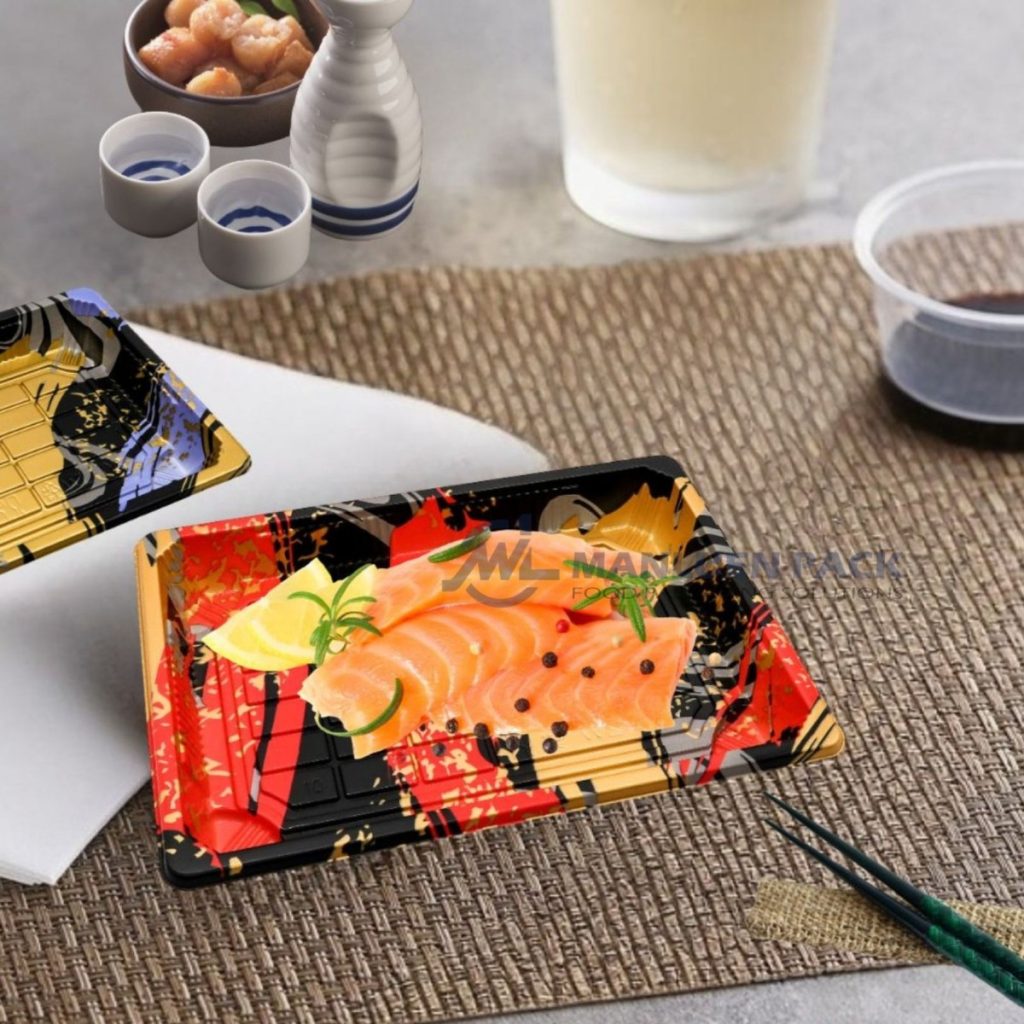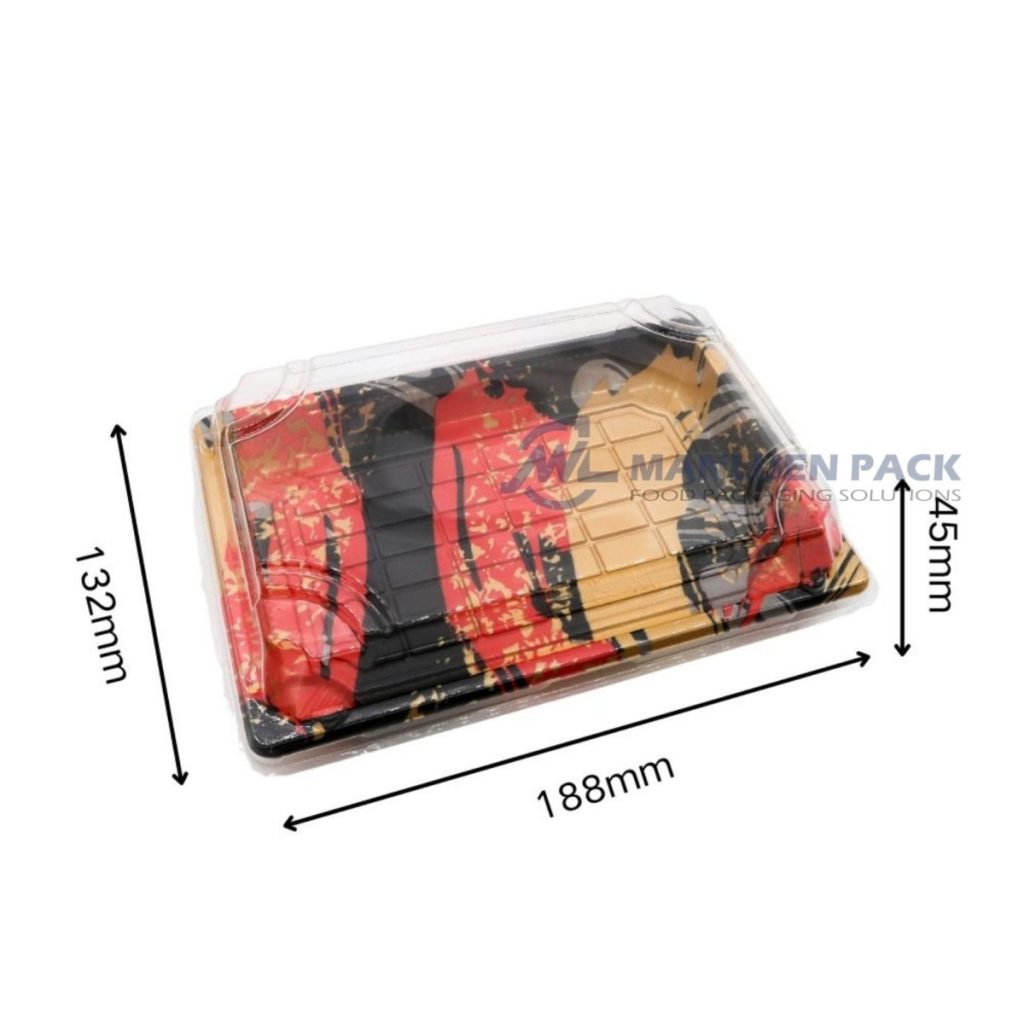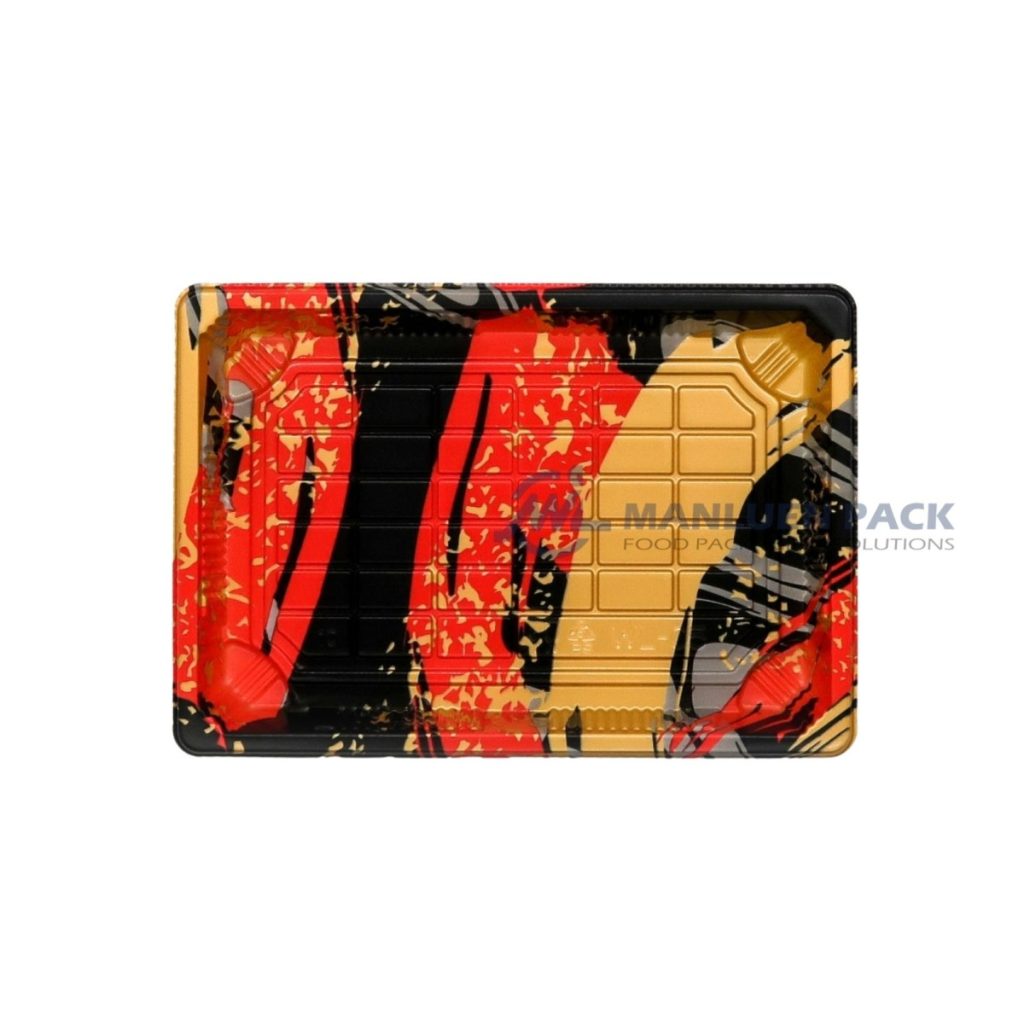How to Choose the Perfect WL-05 Sushi Container Tray for Your Restaurant or Home

To choose the perfect sushi container tray, you should look at material, size, durability, sealability, presentation, and sustainability. The right tray keeps your sushi fresh and safe. Sushi often contains raw fish, which can spoil easily and attract harmful bacteria like E. coli or Salmonella.
Poor packaging and transport can make these risks worse. Bamboo trays help maintain freshness because they have natural antibacterial properties. Plastic trays offer convenience and durability, but they may raise food safety and environmental concerns, especially during long transport. Consider your needs, whether you serve takeout, dine in, or prepare sushi at home.
Key Takeaways
Choose sushi trays that keep sushi fresh and safe by sealing tightly and fitting the sushi well to prevent damage.
Pick trays that enhance presentation with clear lids and stylish designs to make sushi look appealing and boost customer experience.
Match tray size and shape to the type and amount of sushi to keep pieces neat and prevent sliding or squishing.
Consider durability and sealability for transport and storage to keep sushi fresh longer and avoid leaks or damage.
Why Tray Choice Matters
Freshness and Safety
You want your sushi to stay fresh and safe from the kitchen to the table. The right sushi container tray helps protect sushi from air, moisture, and bacteria. A tight seal keeps out germs and keeps the rice from drying out. Plastic trays with clear lids let you check freshness without opening the box. When you choose a tray that fits the sushi well, you prevent pieces from moving around and getting damaged. This keeps your sushi looking and tasting its best.
How you present sushi matters as much as how it tastes. The tray you pick can make your sushi look more appealing and special. Rectangle trays with clear lids let you arrange sushi in creative ways. Customers see the colors and shapes before they even open the box. This makes the meal feel more exciting and fresh. A stylish sushi container tray can turn a simple meal into a memorable experience.
Brand and Perception
Your choice of tray sends a message about your brand. Many customers now look for eco-friendly packaging. They want trays made from bamboo, bagasse, or recycled materials. Younger people and city customers care about the environment and want brands to do the same. When you use sustainable trays, you show that you care about the planet and your customers. This builds trust and loyalty. Custom designs and minimalist styles also help your brand stand out. People remember a restaurant that uses thoughtful, attractive packaging.
Sushi Container Tray Materials

Choosing the right material for your sushi container tray affects freshness, safety, and the environment. Each material has unique strengths and weaknesses. Here is a closer look at the most common options.
Plastic and PET
Plastic, especially PET, is the most widely used material for sushi trays around the world. PET trays are clear, strong, and safe for food. You often see them in restaurants and supermarkets because they show off the sushi and keep it fresh.
Pros:
PET trays are FDA-approved, BPA-free, and chemically resistant.
They seal tightly, which keeps sushi fresh and prevents leaks.
PET is highly recyclable and easy to process in most recycling systems. Clear lids make the sushi look appealing.
| Feature | Plastic/PET Sushi Trays |
| Food Safety | High (FDA-approved, BPA-free) |
| Durability | Very durable, resists cracking |
| Sustainability | Recyclable, but not biodegradable |
| Cost | Low |
| Presentation | Excellent visibility |
Wood and Bamboo
Wood and bamboo trays offer a natural and elegant look. Bamboo, in particular, is popular for eco-friendly brands and premium sushi experiences. Bamboo grows quickly, does not need pesticides, and absorbs more carbon than most plants.
Pros:
Bamboo trays are lightweight, leak-resistant, and durable.
They send a strong message about sustainability.
Bamboo is compostable and biodegradable.
These trays often have certifications like FDA and FSC for safety and sustainability.
Cons:
Wood trays are rare and expensive to make.
Both wood and bamboo can cost more than plastic.
You may need liners to prevent moisture from soaking in.
| Feature | Wood/Bamboo Sushi Trays |
| Food Safety | High (natural antibacterial properties) |
| Durability | Durable, leak-resistant |
| Sustainability | Highly sustainable, compostable |
| Cost | Medium to high |
| Presentation | Premium, natural look |
Paper and Cardboard
Paper and cardboard trays are gaining popularity as people look for greener options. Many of these trays use kraft paper or sugarcane bagasse, which are both compostable and biodegradable.
Pros:
These trays break down naturally and reduce landfill waste.
They are free from harmful chemicals like PFAS and BPA.
Sturdy construction prevents leaks and protects sushi during delivery.
Trays have a clear lid for better presentation.
Cons:
Paper trays may not hold up as well with very moist or oily sushi.
They can cost more than basic plastic trays.
Not all paper trays are suitable for hot foods.
| Feature | Paper/Cardboard Sushi Trays |
| Food Safety | High (no PFAS/BPA, food grade) |
| Durability | Medium (less durable with moisture) |
| Sustainability | Compostable, biodegradable |
| Cost | Medium |
| Presentation | Natural, can include clear Lid |
Bioplastic and BioCane
Bioplastics, such as PLA (corn plastic) and BioCane (sugarcane pulp), are new options for eco-friendly sushi packaging. These materials look and feel like plastic but come from plants.
Pros:
Bioplastic trays are compostable in industrial facilities.
BioCane trays are sturdy, leak-resistant, and safe for food.
Both options help reduce plastic waste and support sustainability goals.
They often meet strict compostability and food safety standards.
Cons:
Bioplastics need special composting conditions to break down.
Availability and cost can vary by region.
| Feature | Bioplastic/BioCane Sushi Trays |
| Food Safety | High (certified compostable, food safe) |
| Durability | Sturdy, leak-resistant |
| Sustainability | Compostable, plant-based |
| Cost | Medium to high |
| Presentation | Modern, eco-friendly look |
Summary Table: Sushi Tray Material Comparison
| Material | Cost | Durability | Sustainability | Pros | Cons |
| Plastic | Low | High | Low | Affordable, durable, moisture-resistant | Not biodegradable, recycling issues |
| Paper | Medium | Medium | High | Eco-friendly, compostable, natural look | Less durable, higher cost |
| Wood/Bamboo | High | High | High | Elegant, sustainable, premium feel | Expensive, needs liners |
| Bioplastic | Medium | Medium | High | Compostable, plant-based, sturdy | Needs special composting; cost varies |
Remember: The best sushi container tray for you depends on your priorities—cost, appearance, food safety, and environmental impact. Many restaurants now choose sustainable materials to meet customer expectations and new regulations.
Key Selection Factors
Size and Shape
Choosing the right size and shape for your sushi container tray helps keep your sushi fresh and looking great. You want a tray that matches the type and amount of sushi you serve. If you use a tray that is too big, the sushi can slide around and lose its shape. If the tray is too small, the sushi may get squished.
Most commercial sushi trays are rectangular. This shape fits well inside sushi rice containers and makes stacking easy.
Some brands offer trays in different heights. Short trays work best for nigiri rice balls.
Compact trays save space and make transport simple. They are lightweight and sturdy, which helps in both restaurants and at home.
For home use, pick a tray that fits your fridge and the number of sushi pieces you plan to store.
For parties, use larger trays to display more sushi at once. For single servings, smaller trays keep portions neat and fresh.
Durability and Sealability
Durability and sealability play a big role in keeping sushi fresh, especially during transport. A strong tray protects sushi from bumps and drops. A good seal keeps out air and moisture, which helps prevent spoilage.
Some trays have a reinforced sealing flange. This creates a tight seal, much like traditional plastic trays, and helps keep sushi fresh for longer.
Trays made from sugarcane bagasse fibers are waterproof and oil-proof. They absorb extra moisture, which helps maintain sushi quality.
Lightweight but sturdy trays work well for delivery and takeout. They protect sushi from damage and keep it safe during travel.
Heat-sealed trays use special technology to lock in freshness. These trays are great for restaurants that deliver sushi.
For home use, always close the tray tightly before storing sushi in the fridge. This keeps the sushi from drying out or picking up odors from other foods.
Aesthetics and Design
Aesthetics and design matter a lot when you choose a sushi container tray. People eat with their eyes first. A well-designed tray makes sushi look more appealing and shows off the chef’s skill.
Consumers rate design as very important; trendy colors or eco-friendly materials attract more customers. Innovative designs help you display sushi in creative ways, making each meal feel special.
For restaurants, a stylish tray can set your brand apart. Custom designs or minimalist looks make your sushi memorable.
At home, a nice-looking tray can turn a simple dinner into a fun event. Kids and guests enjoy sushi more when it looks good.
Cost and Bulk Buying
Cost is always a factor when you pick a sushi container tray. You want a tray that fits your budget but still meets your needs for safety and presentation.
Buying trays in bulk can save money, especially for restaurants. Many suppliers offer discounts for large orders.
Some eco-friendly trays cost more upfront but can boost your brand image and attract more customers.
For home use, you may not need to buy in bulk. Look for multi-use trays that you can wash and reuse.
Think about the balance between price and quality. Cheap trays may save money now but could hurt your sushi’s freshness or appearance.
Eco-Friendly Options
Plastic trays can be recycled, but only if your local recycling center accepts the type of plastic used. Some plastics, including bioplastics, may not be recyclable everywhere. If a tray ends up in a landfill, it can harm the environment for many years. The way you dispose of your tray matters as much as the material itself.
Brand Loyalty
Choosing sustainable packaging does more than help the planet. It also builds trust with your customers. Many people now look for brands that care about the environment. Studies show that:
Sustainable packaging acts as a marketing tool. It makes your brand stand out, encourages people to share their experience, and creates lasting memories.
Brands that focus on sustainability match customer values and build loyalty for the future.
73% of people worldwide say they will change their habits to help the environment.
Top sushi brands now use biodegradable trays to meet these new expectations.
Eco-friendly packaging is not just a trend. Customers expect it, and it helps your business grow.
High-quality, green packaging makes your food feel special and supports your brand story.
Loyalty programs and interactive packaging can make customers come back again and again.
Quick Guide by Use

When you run a restaurant, you want trays that look good and work well. Most restaurants use trays with smooth black finishes and colorful prints. These trays make sushi look more delicious and help your food stand out. Clear lids let your customers see the sushi before they open the box. Rounded corners and tight seals keep sushi fresh and prevent leaks.
Popular choices include:
Plastic trays for their durability and clear lids.
Compostable trays for eco-friendly service.
Takeout and Delivery
For takeout and delivery, you need trays that protect sushi during transport. Look for sturdy, grease-resistant materials. Snap-on lids make packing fast and easy. Compact tray sizes save space and help the environment. Clear lids let customers check their order without opening the box.
Key features to look for:
Leak-resistant and durable construction.
Multiple sizes for different orders.
Compostable options like bagasse or PLA for eco-conscious customers.
A sushi container tray with a tight seal keeps sushi fresh until it reaches your customer. Custom branding on trays can also help people remember your restaurant.
Home
At home, you want trays that are simple and practical. Choose a size that fits your fridge and the amount of sushi you make. Reusable plastic trays work well for family dinners. Paper or bamboo trays add a special touch for parties or celebrations.
You can use trays with compartments to keep different sushi types apart. If you store sushi overnight, place a damp paper towel over the sushi before sealing the tray. This keeps the rice soft and tasty.
Choosing the right tray keeps your sushi fresh, safe, and visually appealing. Studies show that material, size, and sealability all help prevent contamination and boost customer satisfaction.
Eco-friendly trays improve your brand’s reputation and attract loyal, green-minded customers.
Features like clear lids and airtight seals protect sushi during transport and display.
You can upgrade your trays to sturdy, stylish options with custom branding. This simple change builds trust, increases sales, and makes your restaurant stand out.
FAQ
What is the best way to keep sushi fresh in a container tray?
You should use a tray with a tight seal. Place a damp paper towel over the sushi before closing the lid. This keeps the rice moist and prevents drying.
Can I reuse sushi trays at home?
Yes, you can reuse many plastic or bamboo trays. Wash them with warm, soapy water. Check for cracks or stains before each use. Avoid reusing trays that look damaged.
Are compostable sushi trays safe for food?
Compostable trays made from bamboo, bagasse, or bioplastic are food safe. Look for trays with FDA or food-grade certifications. These trays do not contain harmful chemicals.
How do I choose the right tray size for my sushi?
Match the tray size to the number and type of sushi pieces. Use small trays for single servings. Pick larger trays for parties or family meals. This keeps sushi from moving and helps with presentation.
What should I do with used sushi trays?
Recycle plastic trays if your local center accepts them.
Compost bamboo, bagasse, or paper trays if possible.
Throw away trays that cannot be recycled or composted.
How to Get in Touch
Phone Number: +86-17328007523
Email: info@manluenpack.com
